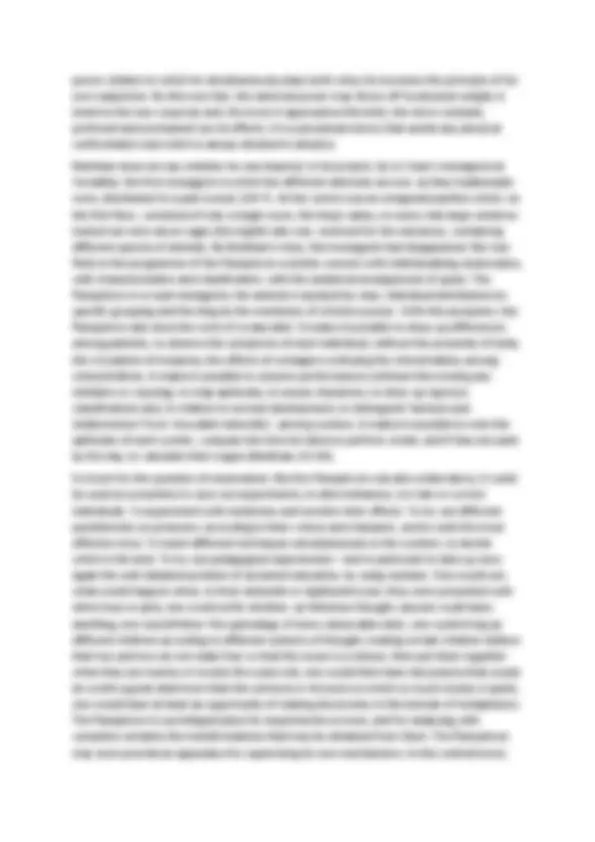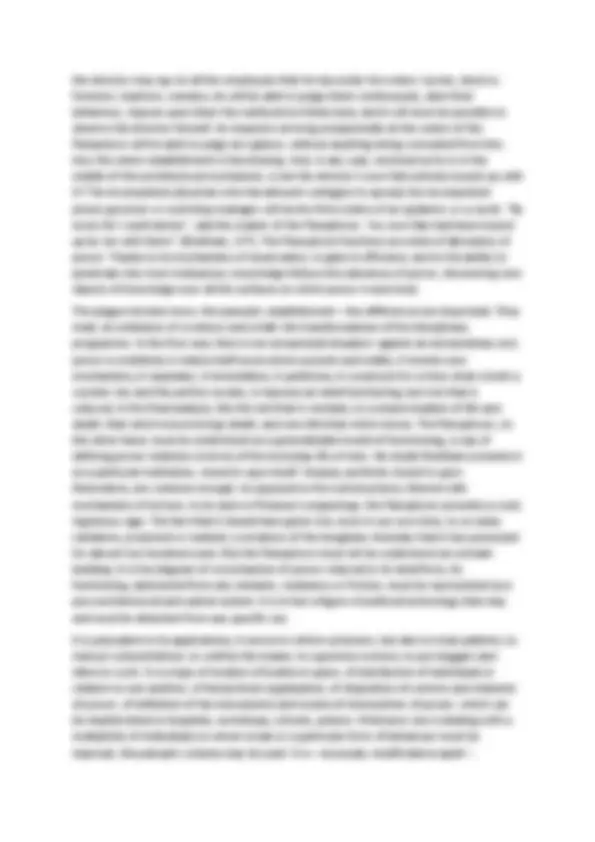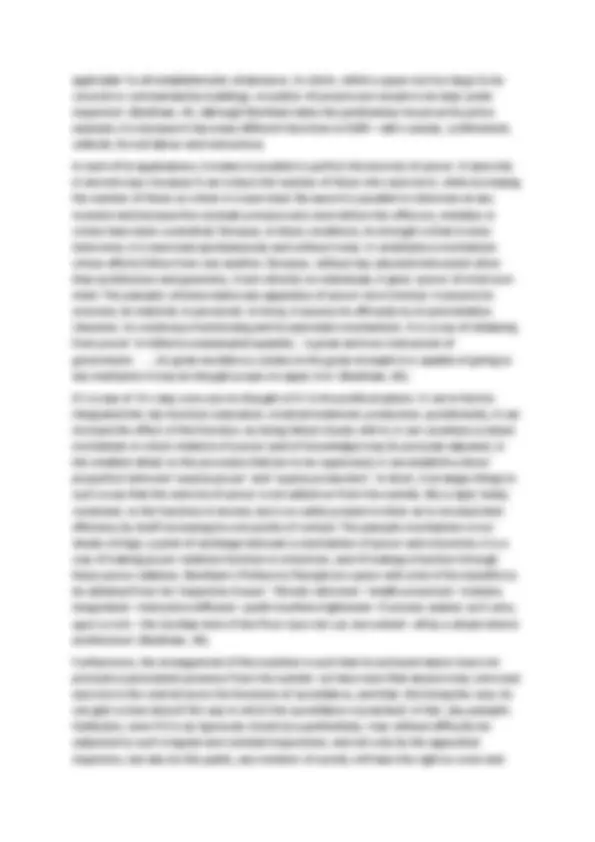





Study with the several resources on Docsity

Earn points by helping other students or get them with a premium plan


Prepare for your exams
Study with the several resources on Docsity

Earn points to download
Earn points by helping other students or get them with a premium plan
Community
Ask the community for help and clear up your study doubts
Discover the best universities in your country according to Docsity users
Free resources
Download our free guides on studying techniques, anxiety management strategies, and thesis advice from Docsity tutors
The Panopticon is a theoretical design for a type of institutional building created by Jeremy Bentham. It is designed to induce a state of permanent visibility among inmates, making them responsible for their own subjection to power. The Panopticon's efficiency lies in its ability to create and sustain power relations independently of the person who exercises it. This architectural design has significant implications for various institutions such as hospitals, schools, prisons, and workshops.
Typology: Schemes and Mind Maps
1 / 7

This page cannot be seen from the preview
Don't miss anything!




Michel Foucault – On the Panopticon Bentham’s Panopticon is the architectural figure of this composition. We know the principle on which it was based: at the periphery, an annular building; at the centre, a tower; this tower is pierced with wide windows that open onto the inner side of the ring; the peripheric building is divided into cells, each of which extends the whole width of the building; they have two windows, one on the inside, corresponding to the windows of the tower; the other, on the outside, allows the light to cross the cell from one end to the other. All that is needed, then, is to place a supervisor in a central tower and to shut up in each cell a madman, a patient, a condemned man, a worker or a schoolboy. By the effect of backlighting, one can observe from the tower, standing out precisely against the light, the small captive shadows in the cells of the periphery. They are like so many cages, so many small theatres, in which each actor is alone, perfectly individualized and constantly visible. The panoptic mechanism arranges spatial unities that make it possible to see constantly and to recognize immediately. In short, it reverses the principle of the dungeon; or rather of its three functions—to enclose, to deprive of light and to hide—it preserves only the first and eliminates the other two. Full lighting and the eye of a supervisor capture better than darkness, which ultimately protected. Visibility is a trap. To begin with, this made it possible—as a negative effect—to avoid those compact, swarming, howling masses that were to be found in places of confinement, those painted by Goya or described by Howard. Each individual, in his place, is securely confined to a cell from which he is seen from the front by the supervisor; but the side walls prevent him from coming into contact with his companions. He is seen, but he does not see; he is the object of information, never a subject in communication. The arrangement of his room, opposite the central tower, imposes on him an axial visibility; but the divisions of the ring, those separated cells, imply a lateral invisibility. And this invisibility is a guarantee of order. If the inmates are convicts, there is no danger of a plot, an attempt at collective escape, the planning of new crimes for the future, bad reciprocal influences; if they are patients, there is no danger of contagion; if they are madmen there is no risk of their committing violence upon one another; if they are schoolchildren, there is no copying, no noise, no chatter, no waste of time; if they are workers, there are no disorders, no theft, no coalitions, none of those distractions that slow down the rate of work, make it less perfect or cause accidents. The crowd, a compact mass, a locus of multiple exchanges, individualities merging together, a collective effect, is abolished and replaced by a collection of separated individualities. From the point of view of the guardian, it is replaced by a multiplicity that can be numbered and supervised; from the point of view of the inmates, by a sequestered and observed solitude (Bentham, 60-64). Hence the major effect of the Panopticon: to induce in the inmate a state of conscious and permanent visibility that assures the automatic functioning of power. So to arrange things that the surveillance is permanent in its effects, even if it is discontinuous in its action; that the perfection of power should tend to render its actual exercise unnecessary; that this architectural apparatus should be a machine for creating and sustaining a power relation independent of the person who exercises it; in short, that the inmates should be caught up
in a power situation of which they are themselves the bearers. To achieve this, it is at once too much and too little that the prisoner should be constantly observed by an inspector: too little, for what matters is that he knows himself to be observed; too much, because he has no need in fact of being so. In view of this, Bentham laid down the principle that power should be visible and unverifiable. Visible: the inmate will constantly have before his eyes the tall outline of the central tower from which he is spied upon. Unverifiable: the inmate must never know whether he is being looked at any one moment; but he must be sure that he may always be so. In order to make the presence or absence of the inspector unverifiable, so that the prisoners, in their cells, cannot even see a shadow, Bentham envisaged not only Venetian blinds on the windows of the central observation hall, but, on the inside, partitions that intersected the hall at right angles and, in order to pass from one quarter to the other, not doors but zig-zag openings; for the slightest noise, a gleam of light, a brightness in a half-opened door would betray the presence of the guardian. The Panopticon is a machine for dissociating the see/being seen dyad: in the peripheric ring, one is totally seen, without ever seeing; in the central tower, one sees everything without ever being seen. It is an important mechanism, for it automatizes and disindividualizes power. Power has its principle not so much in a person as in a certain concerted distribution of bodies, surfaces, lights, gazes; in an arrangement whose internal mechanisms produce the relation in which individuals are caught up. The ceremonies, the rituals, the marks by which the sovereign’s surplus power was manifested are useless. There is a machinery that assures dissymmetry, disequilibrium, difference. Consequently, it does not matter who exercises power. Any individual, taken almost at random, can operate the machine: in the absence of the director, his family, his friends, his visitors, even his servants (Bentham, 45). Similarly, it does not matter what motive animates him: the curiosity of the indiscreet, the malice of a child, the thirst for knowledge of a philosopher who wishes to visit this museum of human nature, or the perversity of those who take pleasure in spying and punishing. The more numerous those anonymous and temporary observers are, the greater the risk for the inmate of being surprised and the greater his anxious awareness of being observed. The Panopticon is a marvellous machine which, whatever use one may wish to put it to, produces homogeneous effects of power. A real subjection is born mechanically from a fictitious relation. So it is not necessary to use force to constrain the convict to good behaviour, the madman to calm, the worker to work, the schoolboy to application, and the patient to the observation of the regulations. Bentham was surprised that panoptic institutions could be so light: there were no more bars, no more chains, no more heavy locks; all that was needed was that the separations should be clear and the openings well arranged. The heaviness of the old ‘houses of security’, with their fortress-like architecture, could be replaced by the simple, economic geometry of a ‘house of certainty’. The efficiency of power, its constraining force have, in a sense, passed over to the other side—to the side of its surface of application. He who is subjected to a field of visibility, and who knows it, assumes responsibility for the constraints of power; he makes them play spontaneously upon himself; he inscribes in himself the
the director may spy on all the employees that he has under his orders: nurses, doctors, foremen, teachers, warders; he will be able to judge them continuously, alter their behaviour, impose upon them the methods he thinks best; and it will even be possible to observe the director himself. An inspector arriving unexpectedly at the centre of the Panopticon will be able to judge at a glance, without anything being concealed from him, how the entire establishment is functioning. And, in any case, enclosed as he is in the middle of this architectural mechanism, is not the director’s own fate entirely bound up with it? The incompetent physician who has allowed contagion to spread, the incompetent prison governor or workshop manager will be the first victims of an epidemic or a revolt. “By every tie I could devise”, said the master of the Panopticon, “my own fate had been bound up by me with theirs” (Bentham, 177). The Panopticon functions as a kind of laboratory of power. Thanks to its mechanisms of observation, it gains in efficiency and in the ability to penetrate into men’s behaviour; knowledge follows the advances of power, discovering new objects of knowledge over all the surfaces on which power is exercised. The plague-stricken town, the panoptic establishment—the differences are important. They mark, at a distance of a century and a half, the transformations of the disciplinary programme. In the first case, there is an exceptional situation: against an extraordinary evil, power is mobilized; it makes itself everywhere present and visible; it invents new mechanisms; it separates, it immobilizes, it partitions; it constructs for a time what is both a counter-city and the perfect society; it imposes an ideal functioning, but one that is reduced, in the final analysis, like the evil that it combats, to a simple dualism of life and death: that which moves brings death, and one kills that which moves. The Panopticon, on the other hand, must be understood as a generalizable model of functioning; a way of defining power relations in terms of the everyday life of men. No doubt Bentham presents it as a particular institution, closed in upon itself. Utopias, perfectly closed in upon themselves, are common enough. As opposed to the ruined prisons, littered with mechanisms of torture, to be seen in Piranese’s engravings, the Panopticon presents a cruel, ingenious cage. The fact that it should have given rise, even in our own time, to so many variations, projected or realized, is evidence of the imaginary intensity that it has possessed for almost two hundred years. But the Panopticon must not be understood as a dream building: it is the diagram of a mechanism of power reduced to its ideal form; its functioning, abstracted from any obstacle, resistance or friction, must be represented as a pure architectural and optical system: it is in fact a figure of political technology that may and must be detached from any specific use. It is polyvalent in its applications; it serves to reform prisoners, but also to treat patients, to instruct schoolchildren, to confine the insane, to supervise workers, to put beggars and idlers to work. It is a type of location of bodies in space, of distribution of individuals in relation to one another, of hierarchical organization, of disposition of centres and channels of power, of definition of the instruments and modes of intervention of power, which can be implemented in hospitals, workshops, schools, prisons. Whenever one is dealing with a multiplicity of individuals on whom a task or a particular form of behaviour must be imposed, the panoptic schema may be used. It is—necessary modifications apart –
applicable ‘to all establishments whatsoever, in which, within a space not too large to be covered or commanded by buildings, a number of persons are meant to be kept under inspection’ (Bentham, 40; although Bentham takes the penitentiary house as his prime example, it is because it has many different functions to fulfil—safe custody, confinement, solitude, forced labour and instruction). In each of its applications, it makes it possible to perfect the exercise of power. It does this in several ways: because it can reduce the number of those who exercise it, while increasing the number of those on whom it is exercised. Because it is possible to intervene at any moment and because the constant pressure acts even before the offences, mistakes or crimes have been committed. Because, in these conditions, its strength is that it never intervenes, it is exercised spontaneously and without noise, it constitutes a mechanism whose effects follow from one another. Because, without any physical instrument other than architecture and geometry, it acts directly on individuals; it gives ‘power of mind over mind. The panoptic schema makes any apparatus of power more intense: it assures its economy (in material, in personnel, in time); it assures its efficacity by its preventative character, its continuous functioning and its automatic mechanisms. It is a way of obtaining from power ‘in hitherto unexampled quantity’, ‘a great and new instrument of government... ; its great excellence consists in the great strength it is capable of giving to any institution it may be thought proper to apply it to’ (Bentham, 66). It’s a case of ‘it’s easy once you’ve thought of it’ in the political sphere. It can in fact be integrated into any function (education, medical treatment, production, punishment); it can increase the effect of this function, by being linked closely with it; it can constitute a mixed mechanism in which relations of power (and of knowledge) may be precisely adjusted, in the smallest detail, to the processes that are to be supervised; it can establish a direct proportion between ‘surplus power’ and ‘surplus production’. In short, it arranges things in such a way that the exercise of power is not added on from the outside, like a rigid, heavy constraint, to the functions it invests, but is so subtly present in them as to increase their efficiency by itself increasing its own points of contact. The panoptic mechanism is not simply a hinge, a point of exchange between a mechanism of power and a function; it is a way of making power relations function in a function, and of making a function through these power relations. Bentham’s Preface to Panopticon opens with a list of the benefits to be obtained from his ‘inspection-house’: ‘Morals reformed—health preserved—industry invigorated—instruction diffused—public burthens lightened—Economy seated, as it were, upon a rock – the Gordian knot of the Poor-Laws not cut, but untied—all by a simple idea in architecture! (Bentham, 39). Furthermore, the arrangement of this machine is such that its enclosed nature does not preclude a permanent presence from the outside: we have seen that anyone may come and exercise in the central tower the functions of surveillance, and that, this being the case, he can gain a clear idea of the way in which the surveillance is practised. In fact, any panoptic institution, even if it is as rigorously closed as a penitentiary, may without difficulty be subjected to such irregular and constant inspections: and not only by the appointed inspectors, but also by the public; any member of society will have the right to come and
show how one may ‘unlock’ the disciplines and get them to function in a diffused, multiple, polyvalent way throughout the whole social body. These disciplines, which the classical age had elaborated in specific, relatively enclosed places—barracks, schools, workshops—and whose total implementation had been imagined only at the limited and temporary scale of a plague-stricken town, Bentham dreamt of transforming into a network of mechanisms that would be everywhere and always alert, running through society without interruption in space or in time. The panoptic arrangement provides the formula for this generalization. It programmes, at the level of an elementary and easily transferable mechanism, the basic functioning of a society penetrated through and through with disciplinary mechanisms. Source: Michel Foucault, Discipline and Punish: The Birth of the Prison , trans. Alan Sheridan (New York: Vintage, 1977), 200–8.